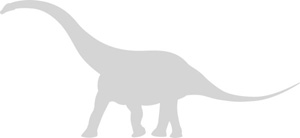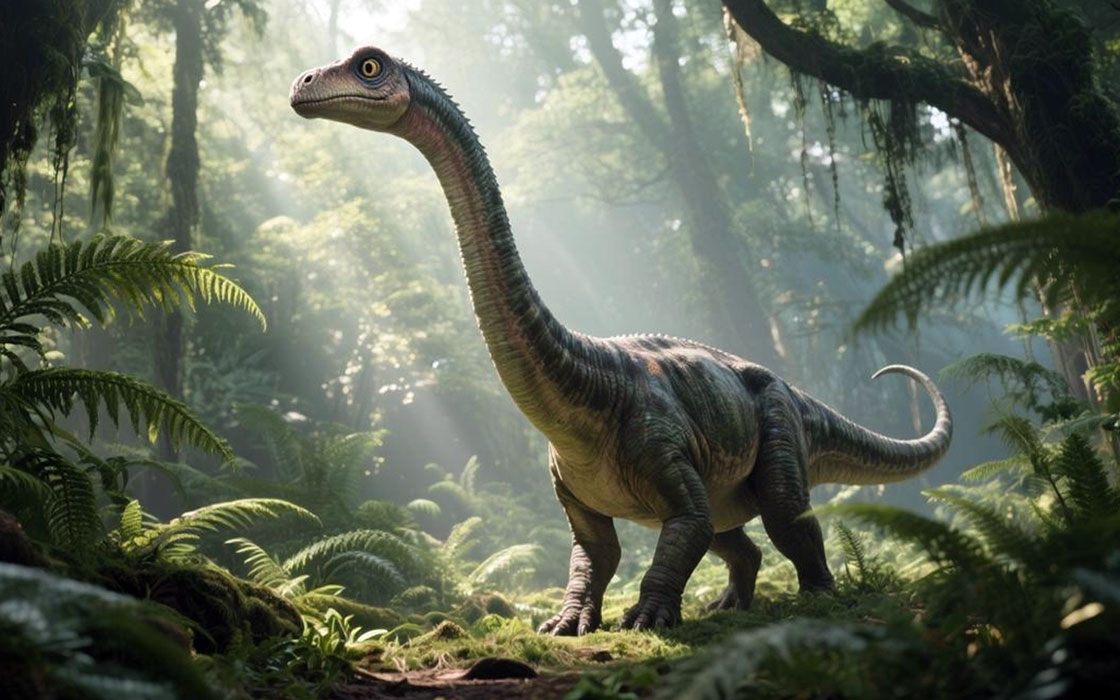Every month, 100,000 readers use the Dinosaur Database, but we receive no support from you. Developing and updating the database requires a lot of work. If you want it to remain open and be updated, please support us via the "Buy us a coffee" button available on every page or via the Support page.
Dinosaur: Huashanosaurus qini

| Length*: | 12 m | 39.4 ft |
| Weight*: | 8 t | 17,637 lb |
*The largest known specimen
Description
Huashanosaurus qini
Huashanosaurus qini was a medium-sized, early-diverging eusauropod sauropod that lived in what is now Guangxi Zhuang Autonomous Region, southern China, during the Early–Middle Jurassic period, approximately 183–163 million years ago (Toarcian–Bajocian stages). It was discovered in the Wangmen Formation, a sedimentary deposit known for lacustrine and fluvial facies sediments with plant fossils and pollen.
The name Huashanosaurus combines “Huashan,” referring to Huashan Mountain in Ningming County, a UNESCO World Heritage Site famous for Zuojiang Huashan rock paintings, with the Ancient Greek “sauros,” meaning “lizard.” The species name qini honors Jian Qin, the local teacher who discovered the site.
As a member of the Eusauropoda clade, Huashanosaurus was closely related to other basal sauropods, showcasing the early radiation of this group in Asia.
Etymology
The genus name “Huashanosaurus” is derived from “Huashan,” referencing Huashan Mountain in Ningming County, Guangxi Zhuang Autonomous Region, southern China, known for its Zuojiang Huashan rock paintings listed as a world heritage site, combined with the Ancient Greek “sauros,” meaning “lizard.” The species name “qini” honors Jian Qin, the local teacher who first reported the fossil site to the Cultural Relics Administration of Ningming County.
Physical Characteristics
Huashanosaurus qini was a medium-sized sauropod, estimated to reach 10–12 m (33–39 ft) in length and weight: 8-10 metric tons. While substantial by modern standards, it is comparable to contemporaries like Shunosaurus lii, though exact comparisons are limited by the incomplete skeleton.
Key anatomical features include:
- A possible dorsal centrum with a deep lateral depression (pleurocoel) and spongy internal structure, ventral surface mildly convex transversely.
- Fragmentary dorsal rib with a rectangular cross-section.
- Three anterior caudal centra that are amphicoelous, with ventral longitudinal hollows and subcircular to subhexagonal cross-sections; one with a horizontal ridge on lateral surfaces.
- Two anterior caudal neural spines, flat laterally and expanded transversely distally, with ratios indicating strong expansion.
- A middle caudal centrum with a strongly concave posterior articular surface and length greater than height.
- Distal part of the left humerus with a medial anterodistal process, moderately deep anconeal fossa, and rugose distal surface.
- Proximal part of the left ulna with a triradiate end, strongly concave anteromedial process, hook-shaped posterior process (autapomorphy), and crescent-shaped cross-section below the posterior process (autapomorphy).
- A right manual phalanx that is subrectangular, broader transversely than long, with concave proximal and distal ends.
- Preacetabular process of the left ilium tapering dorsoventrally and anteriorly to a point.
- Distal part of the left femur with an anteroposteriorly compressed shaft and rugose distal end.
- Distal part of the right fibula expanded anteroposteriorly and medially, with a longitudinal groove on the posterodistal surface (autapomorphy).
- Proximal part of the left metatarsal V with a subtriangular proximal surface.
- A right pedal phalanx that is subtrapezoidal in dorsal view, with concave proximal surface and distinct distal condyles.
- Incomplete left pedal ungual I that is laterally compressed, with a concave proximal surface.
These features indicate a robust structure typical of basal eusauropods, with autapomorphies distinguishing it from relatives.
Diet and Feeding Habits
As a herbivorous sauropod, Huashanosaurus qini fed on a variety of plants that thrived in the Early–Middle Jurassic ecosystems of Asia. Its diet likely included:
- Ferns and cycads, which were abundant in its environment.
- Conifers, the dominant trees of the time.
- Early seed plants, which were common during the Jurassic.
Like other eusauropods, Huashanosaurus probably relied on its long neck to browse vegetation at different heights, allowing it to access food sources that smaller herbivores could not reach.
Habitat and Distribution
Huashanosaurus qini lived in what is now southwestern Guangxi Zhuang Autonomous Region, southern China, specifically in the Wangmen Formation of the Shiwandashan Basin, a geologic unit that preserves lacustrine and fluvial facies sediments.
Its environment was characterized by:
- Lakes and rivers, creating a humid, fertile landscape.
- Seasonal climate fluctuations, with periods of wet and dry conditions.
- Diverse vertebrate fauna, including bony fish scales and teeth (possibly Lepidotes sp.) and plesiosaurian teeth.
The Wangmen Formation has yielded fossils of plants and pollen, but Huashanosaurus qini is one of the few dinosaur representatives from this unit.
Paleoenvironment
The discovery site was a lacustrine and fluvial facies sediment in an ancient continental basin. During the Early–Middle Jurassic, temperatures were warmer than today, with water sources like rivers concentrating biodiversity. The fossil assemblage includes fish, plesiosaurs, and fragmentary dinosaur bones, providing a snapshot of the ecosystem in which Huashanosaurus qini thrived.
Behavior and Social Structure
Although no direct evidence of social behavior has been found for Huashanosaurus qini, many sauropods are thought to have exhibited herding behavior for protection and migration. Possible behaviors include:
- Living in small herds or family groups, as seen in some sauropod trackways.
- Migrating seasonally in search of food and water.
- Using size as a defense, though Huashanosaurus was medium-sized and may have relied on its environment for protection.
As an eusauropod, it likely adopted a quadrupedal gait, supporting bulk herbivory in a diverse ecosystem.
Discovery and Research
The fossils of Huashanosaurus qini were discovered in the Wangmen Formation at Huqiu Quarry near Dongshi Village, Beijiang Town, Ningming County, Guangxi Zhuang Autonomous Region, southern China. The holotype and paratype consist of disarticulated partial skeletons, which were used to identify it as a new genus and species of eusauropod.
This discovery provides important insights into the diversity of eusauropods in southern China, showing their early radiation.
Discovery Context
The fossils of Huashanosaurus qini were unearthed at Huqiu Quarry near Mingjiang River, initially found in 2002 by Jian Qin while searching for ornamental stones, with subsequent excavations in 2017 by the Natural History Museum of Guangxi and the Cultural Relics Administration of Ningming County. The site, dating back approximately 183–163 million years, was a lacustrine-fluvial environment, and the specimens are assigned to the same individual based on size and morphology.
Significance and Interesting Facts
- One of the basal eusauropods from southern China, highlighting the radiation of this clade in Asia.
- Discovered in the Wangmen Formation, which has also yielded fish and plesiosaur remains.
- Provides evidence of ecological diversity among eusauropods, suggesting adaptations in forelimb and hindlimb elements.
- Named in honor of Jian Qin, recognizing his role in the discovery.
- Demonstrates that eusauropods diversified during the Early–Middle Jurassic, with implications for the age of the Wangmen Formation.
Conclusion
Huashanosaurus qini was a medium-sized, basal eusauropod from the Early–Middle Jurassic of China, showcasing the early evolution of sauropods in Asia. While many sauropods grew to enormous sizes, Huashanosaurus represents an early-diverging member of the lineage. Its discovery helps paleontologists understand the range of morphologies and ecological roles played by eusauropods in prehistoric southern China.
Locations
Sources
Material: Incomplete dorsal centrum, incomplete dorsal rib, distal part of left humerus, proximal part of left ulna, manual phalanx, incomplete left ilium, distal part of femur, distal part of fibula, incomplete metatarsal V, incomplete pedal ungual; three anterior caudal vertebrae, one middle caudal vertebra, one anteriormost caudal neural spine, one anterior caudal neural spine, one pedal phalanx
References: Mo, Jinyou; Zhou, Xiuzhen; Fu, Qiongyao; Xiong, Duo; Hu, Minhang; Xu, Xing (2025-08-19). "A new eusauropod dinosaur from the Lower and Middle Jurassic Wangmen Formation of Ningming County, Guangxi, South China"




